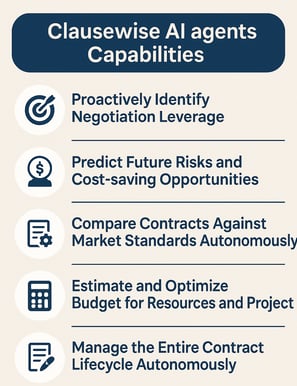The Evolution of Contract Intelligence: From Manual Review to Autonomous Analysis


Contracts. They are the bedrock of every business relationship, the intricate web that defines obligations, mitigates risks, and fuels growth. Yet, for decades, the process of understanding, managing, and extracting value from these critical documents has been largely manual – a time-consuming, error-prone, and often frustrating endeavor. But the landscape is shifting dramatically. We are witnessing a profound evolution in contract intelligence, moving from painstaking manual review to the dawn of autonomous analysis powered by Artificial Intelligence.
Welcome to the evolution of contract intelligence from tedious manual review to intelligent, autonomous analysis driven by Artificial Intelligence.
The Age of Human Eyes and Endless Hours:
Think back to the traditional contract lifecycle. Legal teams and stakeholders would spend countless hours combing through dense legal text, searching for key clauses and buried risks.
This outdated process was marked by:
Time Inefficiency: Complex contracts could take weeks or months to review and approve.
Resource Drain: Cross-functional teams spent excessive time on contract work instead of strategic tasks.
Human Error: Overlooked clauses, misinterpretations, and compliance gaps were common.
Limited Scalability: Contract volume grew with the business, but the headcount had to grow with it.
Reactive Insights: Reviews focused on the present moment, not future risks or opportunities.
Siloed Knowledge: Contract data was fragmented across teams, systems, and formats.
While necessary in the past, this manual process created significant bottlenecks and business risks.
The First Glimmers of Automation: Contract Lifecycle Management (CLM) Systems:
The first wave of evolution came with the introduction of Contract Lifecycle Management (CLM) systems. These platforms brought much-needed structure and automation to the process of contract management. They offered features like:
Centralized repositories for storing and organizing contracts.
Workflow automation for routing approvals and managing tasks.
Basic search and tracking functionalities.
Standardized templates and clause libraries.
CLM systems were a significant step forward, streamlining workflows and improving organization. However, the intelligence applied to the contracts themselves remained largely human-driven. While CLM systems made it easier to manage contracts, they didn't inherently understand them.
The AI Revolution: Intelligent Contract Analysis Emerges:
The true paradigm shift began with the advent of Artificial Intelligence, particularly Natural Language Processing (NLP) and Machine Learning (ML). This marked the emergence of Intelligent Contract Analysis (ICA). AI-powered tools started to augment human capabilities by:
Automated Clause Extraction: Quickly identifying and categorizing key clauses like payment terms, termination clauses, and liability limitations.
Risk Identification: Flagging potentially problematic or non-standard clauses based on predefined rules and machine learning models.
Compliance Checks: Ensuring contracts adhere to regulatory requirements and internal policies.
Basic Negotiation Support: Providing insights based on historical data and common negotiation points.
Improved Search Functionality: Enabling users to search for specific information across vast contract repositories with greater accuracy.


ICA tools represented a significant leap, automating many of the time-consuming and repetitive tasks associated with manual review. They empowered legal and business teams to focus on higher-level strategic thinking and decision-making.
The Dawn of Autonomous Analysis: Agentic AI Takes Center Stage:
Now, we stand at the cusp of an even more transformative phase: Autonomous Contract Analysis powered by Agentic AI. This next evolution promises to move beyond simple automation and augmentation towards truly intelligent and proactive contract understanding and management.
Imagine AI agents that can:
Independently Review and Analyze Contracts: Going beyond simple extraction to deeply understand the context, intent, and implications of complex legal language.
Proactively Identify Negotiation Leverage: Based on real-time market data and precedent, suggesting optimal negotiation strategies without human intervention.
Predict Future Risks and Opportunities: Leveraging predictive analytics to forecast potential contractual issues or cost optimization possibilities before they arise.
Compare Contracts Against Market Standards Autonomously: Identifying deviations, potential inefficiencies, and emerging risks without requiring manual benchmarking.
Score Risk and Recommend Remediation: Automatically assessing risk at clause and contract levels and suggesting specific actions to mitigate those risks.
Manage the Entire Contract Lifecycle Autonomously: From initial review and negotiation to post-signing management and renewal, with minimal human oversight.
ClauseWise AI: Leading the Charge Towards Autonomous Contract Intelligence:
At ClauseWise AI, we are at the forefront of this exciting evolution. Our agentic AI platform is designed to move beyond the limitations of traditional CLM and basic ICA, offering a glimpse into the future of autonomous contract analysis. By empowering businesses with real-time market intelligence, predictive capabilities, and comprehensive CLM functionality, we are enabling them to unlock unprecedented efficiency, mitigate risks proactively, and secure more favorable terms in their critical IT outsourcing agreements.
The journey from manual review to autonomous analysis is not just about speed and efficiency; it's about transforming contracts from static documents into dynamic sources of strategic advantage. As Agentic AI continues to evolve, the future of contract intelligence promises a world where businesses can truly understand, leverage, and optimize their contractual relationships with unprecedented ease and insight.
Read more, Benchmarking Your IT Contract Terms Against Market Standards: A Practical Guide
